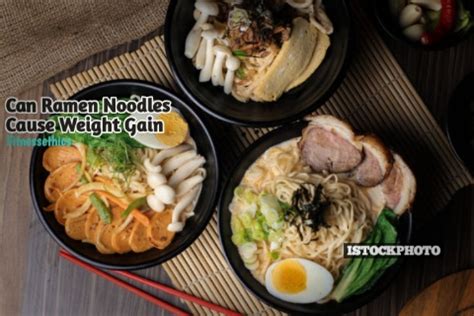Ramen, a popular Japanese dish consisting of wheat noodles in a savory broth, has become a global phenomenon. While it’s often enjoyed as a comforting meal, concerns about its potential impact on weight gain linger. This article delves into the nutritional implications of ramen and explores factors that influence its weight gain potential.

Nutritional Breakdown
A standard bowl of ramen contains approximately:
- Calories: 500-700
- Fat: 20-30 grams
- Carbohydrates: 60-70 grams
- Protein: 20-30 grams
- Sodium: 1,000-2,000 milligrams
Weight Gain Potential
The primary concern regarding ramen and weight gain lies in its high caloric content. A single bowl can account for a significant portion of an individual’s daily calorie intake. However, it’s important to consider additional factors that contribute to weight gain:
Calories
The number of calories consumed plays a crucial role in weight gain. As mentioned earlier, ramen contains a substantial amount of calories. Frequent consumption or excessive portions can lead to a calorie surplus, promoting weight gain.
Macronutrients
Ramen is primarily composed of carbohydrates and fat. Excessive consumption of carbohydrates can lead to increased glucose levels in the blood, triggering the release of insulin. Insulin promotes the storage of glucose as fat.
Sodium
High sodium intake can cause fluid retention, leading to temporary weight gain. Ramen often contains high levels of sodium, which can contribute to this problem.
Factors to Consider
Serving Size
The portion size of ramen can significantly impact its weight gain potential. Larger portions contain more calories, fat, and sodium. Opting for smaller portions can help mitigate weight gain concerns.
Broth Type
Ramen broth varies in fat content. Tonkotsu broth, made from pork bones, is richer in fat than other broths, such as shoyu or miso. Choosing low-fat broth options can reduce calorie intake.
Toppings
Toppings added to ramen can significantly increase calorie and fat content. Typical toppings like egg, chashu pork, and fried onions add substantial calories. Limit high-calorie toppings or opt for healthier alternatives like vegetables.
Frequency of Consumption
Occasional ramen consumption within a balanced diet is unlikely to lead to weight gain. However, frequent or excessive consumption can contribute to a calorie surplus and potentially promote weight gain.
Ways to Make Ramen Healthier
Reduce Carbohydrates
Consider using shirataki noodles instead of traditional wheat noodles. Shirataki noodles are low in calories and carbohydrates, making them a healthier alternative.
Opt for Lean Protein
Choose lean protein toppings, such as chicken or tofu, instead of chashu pork. These options provide protein without the excess fat.
Choose Low-Sodium Broth
Select low-sodium broth options or prepare homemade broth with a controlled amount of salt. This can significantly reduce sodium intake.
Add Vegetables
Incorporate vegetables into your ramen, such as spinach, mushrooms, or onions. Vegetables provide essential nutrients and fiber while adding minimal calories.
Conclusion
Ramen can be enjoyed as part of a balanced diet without necessarily leading to weight gain. However, factors such as serving size, broth type, toppings, and frequency of consumption should be considered to minimize its weight gain potential. By opting for healthier ingredients and limiting excessive consumption, ramen can be enjoyed as a guilt-free treat.
